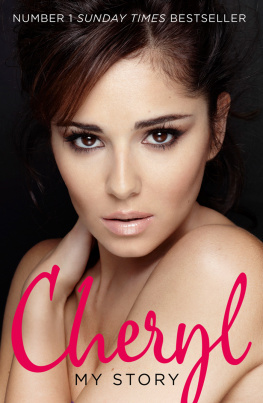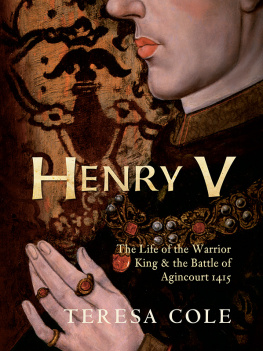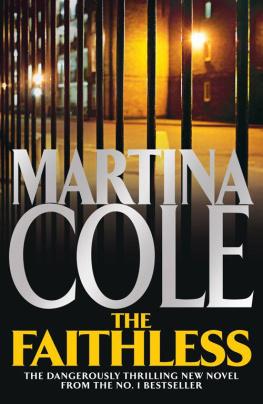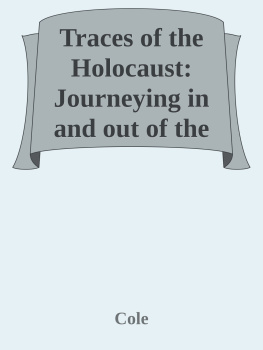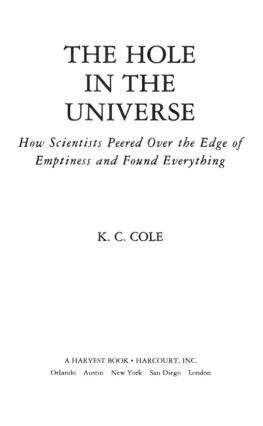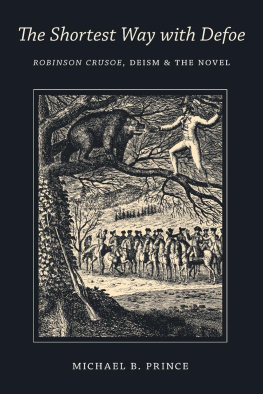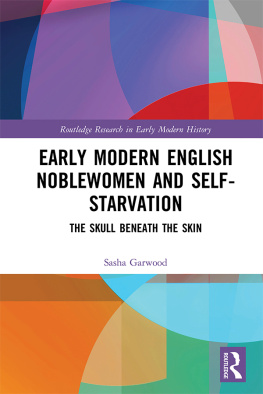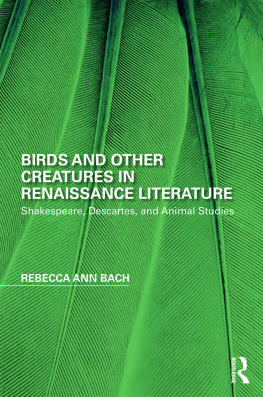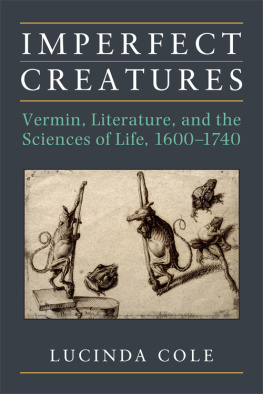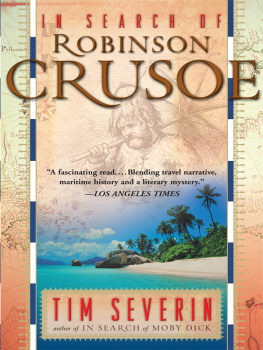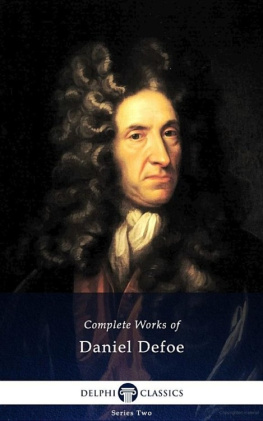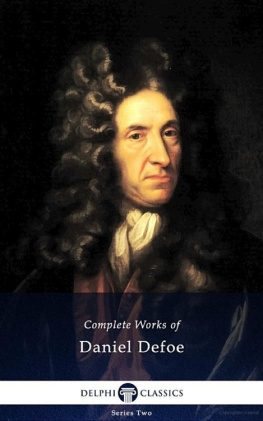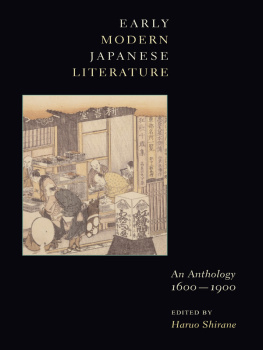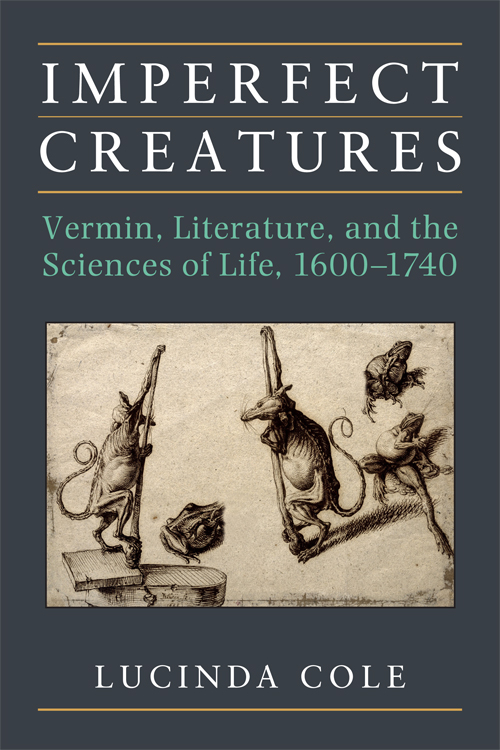
Imperfect Creatures
Imperfect Creatures
Vermin, Literature, and the Sciences of Life, 16001740
Lucinda Cole
University of Michigan Press
Ann Arbor
Copyright University of Michigan 2016
All rights reserved
This book may not be reproduced, in whole or in part, including illustrations, in any form (beyond that copying permitted by Sections 107 and 108 of the U.S. Copyright Law and except by reviewers for the public press), without written permission from the publisher.
Published in the United States of America by the
University of Michigan Press
Manufactured in the United States of America
A CIP catalog record for this book is available from the British Library.
ISBN 978-0-472-07295-8 (hardcover : alk paper)
ISBN 978-0-472-05295-0 (cloth : alk. paper)
ISBN 978-0-472-12155-7 (ebook)
My grateful thanks, first, to my editor Aaron McCollough at University of Michigan Press, who perceived the academic value of this quirky project, and to Mary Hashman, Allison Peters, and others in Ann Arbor who saw it through to the end.
During the course of this research, I received help from staff at several libraries in the United States: The Newberry, University of Southern Maine, University of Illinois Urbana-Champaign, and Bowdoin College. The Kupferstichkabinett at the Staatliche Museum of Berlin provided access to the drawings of Jacques de Gheyn II, without which Imperfect Creatures might never have been conceived. Laura Otis, Thomas Pfau, and Heidi Hartwriter provided invaluable scholarly assistance in securing these permissions.
In the early stages of this project, Tito Chico and Cristobal Silva at Eighteenth Century: Theory and Interpretation gave me the opportunity to edit a special issue on animal studies. Contributors Bruce Boehrer, Erica Fudge, Laura Brown, Donna Landry, Richard Nash, Jonathan Lamb, and Cary Wolfe showed me how animal studies might be done. Rick Barney, Helene Scheck, and the readers at Journal for Early Modern Cultural Studies, along with participants at a 2009 Rhetorics of Plague conference, offered positive feedback and sound advice as I worked to articulate why, even prior to germ theory, vermin played crucial roles in early modern biopolitics.
Over the years, Ive benefited immeasurably from the conversation, scholarship, and interdisciplinary fervor of my SLSA (Society for Literature, Science, and the Arts) family: Karen Raber (no stranger to parasites), Susan McHugh, Bruce Clarke, Nigel Rothfels, Arielle Saiber, Ann Kibbie, Christopher Morris, Spencer Schaffner, Melissa Littlefield, Carol Colatrella, Laura Otis, Stacy Alaimo, Kari Weil, and Susan Squier. The humorous, wise, and generous Richard Nash has been a pillar of support. Ron Schleifer, whose intellectual generosity is well known, gave me crucial guidance at key stages in this process. Rajani Sudans cats run through chapter 5, and her cheerful skepticism about the anthropocene partially motivated the final pages of this book.
Colleagues at the University of Southern Maine who have supported my work in animal and ecological studies over the years include Eve Raimon, Rick Swartz, Lorrayne Carroll, Wendy Chapkis, Lauren Webster LaFrance, Kathleen Ashley, Susan Feiner, Robert Louden, and Jane Kuenz. Nancy Gish deserves special thanks for her ongoing vermin alerts and Rick Abrams for his early and invaluable comments on Shakespeare. In Piers Beirne, I found a role model and fellow traveler. Because they populated my interdisciplinary classes, USM students enabled me to write this book; from Caitlin Huber and Meaghan LaSala, I learned more than I taught. Bret Tonelli gave me courage. My friends at BowdoinDavid Collings, Terri Nickel, and Celeste Goodridgehave been good-natured, patient, and valuable listeners through the books many stages, and endless sources of texts, food, wine, and insight.
Over the past five years, I have leaned heavily on members of my family, and this book is as much theirs as it is mine. First, my parents and my sister Melanie gave me the opportunity for concentrated work when, during my last sabbatical, they welcomed me, and the dogs, while I wrote. My mother, Jean Cole, was an unfailing source of love and inspiration. My father, Marvin Cole, passed away shortly after I completed the manuscript, and I only wish that he had seen this book in its published form. It would have made him smile. Finally, my husband Robert Markley served heroically as reality checker, mood booster, copyeditor, tea servant, and dog walker. Imperfect Creatures is dedicated to Bob, the most perfect of all the imperfect creatures I know.
Contents
Reading beneath the Grain
CLOV : (anguished, scratching himself):
I have a flea!
HAMM : A flea! Are there still fleas?
CLOV : On me theres one. (Scratching.)
Unless its a crab louse.
HAMM . (Very perturbed.)
But humanity might start from there all over again!
Samuel Beckett, Endgame
In the last three decades, animal studies has influenced every discipline in the humanities, including literary studies, encouraging scholars to acknowledge the anthropocentrism of the stories we have been telling about ourselves and the natural world. Nuanced analyses of what Aristotle called the more perfect creatures have introduced new life forms into traditional literary and cultural history, so that once-overlooked references to horses, dogs, apes, bears, cats, wolves, and other beasts in early modern texts now shimmer again with complex meaning.so rapidly and in such numbers they threaten to overwhelm their biological, environmental andfrom a human perspectivesociolegal contexts.
The first full-length study of vermin in the early modern period, Imperfect Creatures is not a straightforward cultural history but an interdisciplinary analysis of how and why these reproducing animal populations, perceived as threats to a fragile food supply, make their way into seventeenth- and early eighteenth-century literature and philosophy. Vermin play an important role in Shakespeares Macbeth; they are natural antagonists in the plague poetry of Abraham Cowley; and they enable Thomas Shadwells satire of science, along with his critique of a parasitical social order. As the constitutionally simple beings against which the complexity of the human brain and body are defined, imperfect creatures anchor experiments in early modern neuroanatomy. And disappearing magically from Crusoes wrecked ship, they serve as the absent center of an island economy that has grounded discussions of modern subjectivity and political economy. By bringing scholarship from agricultural history, environmental history, and medical history to bear on these and other works of literature, I argue rats, frogs, flies, and other animals located at the limits of our now-suburban zoography have shaped humanist practices, writings, and systems of thought. My historical focus is on the period 1600 to 1740, when religion, art, and science, in different ways, cast vermin as agents in studies of, and debates about, the socionatural world. Throughout this period, fleas, worms, wasps, maggots, and other swarming things carried considerable metaphysical and ethical weight, continually reshaping fundamental categories of analysis and perception.
By far, the most sustained body of scholarship on vermin during the early modern period has been written by medical and agricultural historians: the former focus on microscopy and plague treatises, and the latter focus on farming and extermination manuals. Medical historians trace a line of thought linking vermin and disease that runs through the works of Athanasius Kircher (160180), William Harvey (15781657), Robert Hooke (16051703), Antony van Leeuwenhoek (16321723), Francesco Redi (162697), Marcello Malpighi (162894), Jan Swammerdam (163780), and Sir William Ramsay, author of the first full-length treatise on worms in English.
Next page

